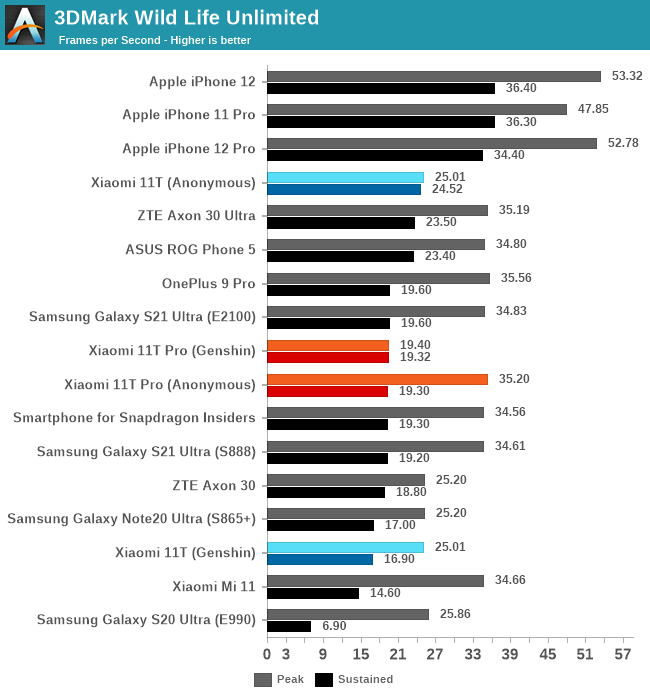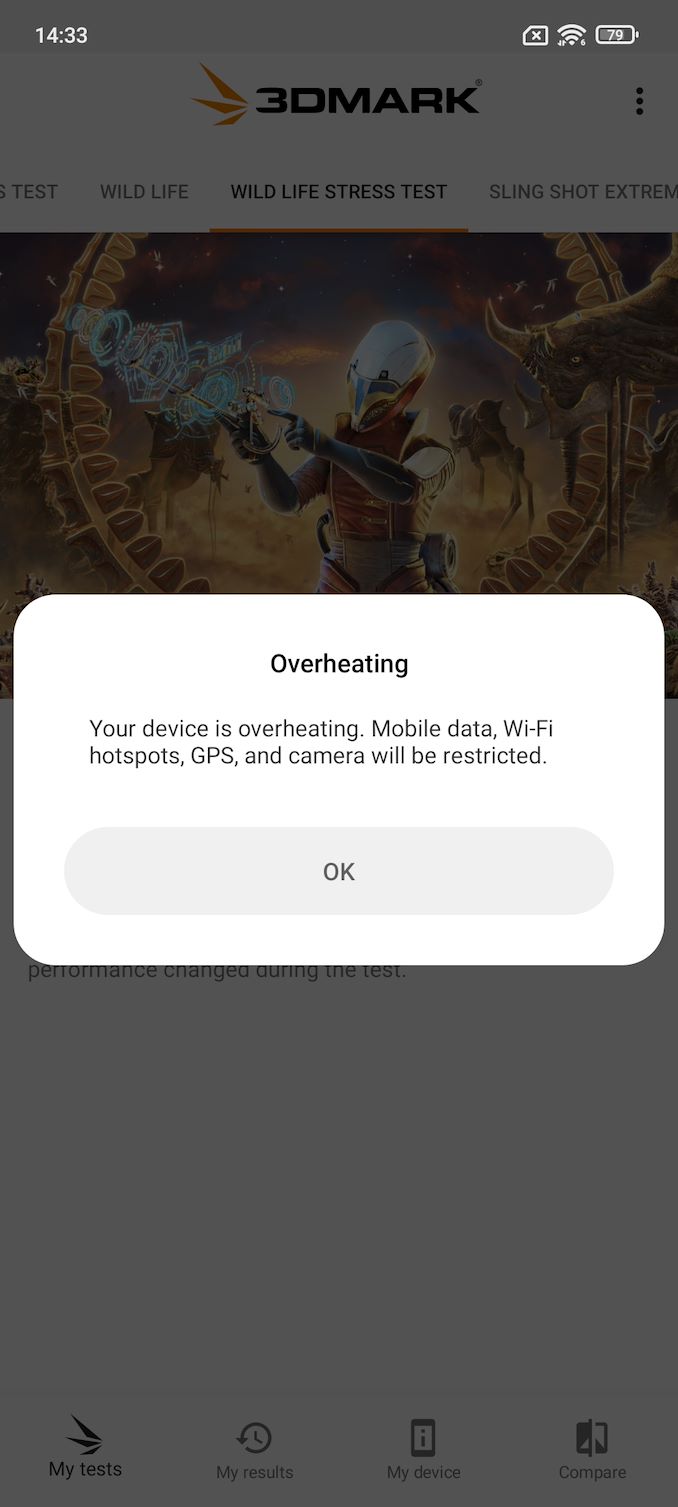The Xiaomi 11T & 11T Pro Review: Two Chips, With a Battery Focus
by Andrei Frumusanu on September 15, 2021 9:00 AM EST- Posted in
- Mobile
- Smartphones
- Xiaomi
- Xiaomi 11T
- Xiaomi 11T Pro
GPU Performance - More "Optimisations"
On the GPU side of things, it’s again a very interesting to match up the Snapdragon 888 versus the Dimensity 1200. The Snapdragon should dominate in peak performance, however sustained is another question.
Unfortunately, the 11T Pro here is again a Snapdragon Xiaomi device like many that we’ve seen in the past – the issue here being is that the phone just outright doesn’t throttle at all. In anonymous applications, the phone will go full power no matter the temperature until at some point it’ll give out an overheating warning.
The MediaTek 11T also didn’t throttle at all, and although the phone reached 47°C at least it didn’t give off any overheating warning.
Lately I’ve been spoofing our workloads as popular games, specifically Genshin Impact, given it’s the most popular and most demanding real world gaming title out there. Benchmarking the game itself is hard because of the dynamic resolution and differing graphics settings depending on devices, but spoofing a standardised workload as the game work well to showcase representative gaming performance.

Unfortunately, this experiment here showcases Xiaomi’s shenanigans:
First off with the MediaTek 11T: the anonymous test doesn’t throttle at all and peak and sustained performance figures are essentially the same, with the chip actually faring quite well here in sustained performance, not accounting for the hot phone.
In the Genshin spoofed test, the device has drastically lower thermal behaviour, and throttles at lot quicker to lower performance states. He phone was generally only 39°C warm which was very good.
On the Snapdragon 11T Pro, there’s quite the shocking revelation; the phone is outright capping peak performance, gutting it to otherwise the sustained performance levels of the anonymous version (before the overheating warning).
Thermals of the phone here are excellent at only around 37°C peak skin temperatures. Generally, the prolonged gaming performance here isn’t changed as the both end up at the same level.
The problem with this “optimisation” is of course that it’s completely misleading the benchmarks. If real games are actually severely limited in GPU frequency and performance, then this should also be represented in benchmarks for transparency.
I’m very exhausted by these opaque mechanisms, because most other reviewers will likely not catch them, which is likely Xiaomi’s goal. It’s a crap industry behaviour that needs to be abolished.
I’m skipping over the rest of the benchmarks here as it’s not even worth showcasing.











41 Comments
View All Comments
beginner99 - Thursday, September 16, 2021 - link
Hence you should disable fast charging and only enable it when your really need it. Plus not go below 20% too often and not leave it plugged in at 100% overnight.philehidiot - Thursday, September 16, 2021 - link
Myself I have a balance between battery and lifestyle. I'm not rearranging my life around battery longevity and I've a local phone shop that does reasonably priced battery swaps. You lose waterproofing, though. I slow charge with a slow wireless charger overnight (to preserve the USB port which is a known weakness on my phone) and have "fast cable charging" disabled. So when I go on holiday, I take a normal wired charger and the super fast one. The super fast cable charging is enabled but there's no way of mixing it up as it's the only time I ever use that charger and I have to consciously get it. When you're in a rush, the last thing you want to do is mess around with charging options.It's not the most optimal solution for battery life, but I also bought a phone with a battery that would easily last a day and a half when I got it, so there is room to drop before it really impacts my routine.
I'll be very interested to see what this article has to say on the effect of fast charging on battery life. It's infuriating that people just aren't aware of the problems to the point that they'll actively challenge something that has been well established for decades - fast charging repeatedly damages batteries.
timecop1818 - Wednesday, September 15, 2021 - link
xiaomi makes a lot of USB power banks, so they should have experience with high charge/discharge battery cellsssdj - Thursday, September 16, 2021 - link
Xiaomi has a share in sunwoda, world's leading battery manufacturer on par with coslight.abufrejoval - Wednesday, September 15, 2021 - link
Well, it is becoming more and more difficult to achieve the miracles vendors want to sell and consumers want to brag about...But will consumers be unhappy with these devices, even when they are throttled to where they no longer burn their fingers (and the battery)? Probably not.
The main message for me is: Little benefit from new devices in terms of performance.
Limited battery life time, ever more fragile devices and limited software support unfortunately won't let us just keep our existing phones until things get interesting again.
GC2:CS - Wednesday, September 15, 2021 - link
Well thanks for your work an article on those FTL charging methods would be greatly appreciated.I do have a suspicion that something is wrong with "charges in 15 minutes and 120W in phone thing" when the basics are still lithium ions and cobalt oxide housing. They do not like high currents and high temperatures. And nobody talks about negatives. All I see is fanboys screaming "ur phone charges slower than a snail !"
So a thorough deep dive would be appreciated. Should I charge my notebook at 5W then ?
dragosmp - Wednesday, September 15, 2021 - link
Probably not at 5, but not at 120W either. For every battery chemistry and build quality there is a "maximum" charging speed for which there is no heat accumulation and no separator damage. If it's a "power" cell, aka a cell with a thinner and more permeable separator, then you can charge at higher power, but you get less Wh per volume. Power cells also tend to get higher self-discharge. At 5000mAh, so 5Ah, for an average 3.8V, 1C charging is 18W. 18W is surely safe, and probably somwere between 18 and 36W is safe too below 80% SoC. For more than that, it depends on the cell, heatsink/phone and charging curve - which is why I'm with Andrei on testing the battery inside the phone, as opposed to on a table with open airflow and maybe too keeping temps in check.Wrs - Wednesday, September 15, 2021 - link
There is already so much one can do with lithium and cobalt (or manganese sometimes).. what it boils down to is how good the design is and how well it's manufactured. Remember years back when we worried about whether 15W quick charging would lead to shortened lifespan compared to 5W charging? You could say back then designs were less advanced - production methods were not as refined, and the product has to be perfect btw, one mistake and a fire erupts in someone's pocket.I'm of course curious about how much degradation happens at 120w peaks compared to 15 or 25w. Someone will have to test that long-term. And then we'll have to ask whether that's significant or practically meaningful. Degradation is not really a fixed percentage; it's more like an added resistor to the battery. Draw high testing current and you'll see much higher % aging than if you draw low current. All that is relative to battery size. That's why Apple had that "fiasco" with performance throttling on older iPhones. Their battery designs tend to be smaller and more conservative (less cutting-edge). I will say I appreciate seeing a contrasting manufacturer who keeps pushing the edge - all this research prepares us for what we might see as standard tomorrow.
NextGen_Gamer - Wednesday, September 15, 2021 - link
Small (but funny typo): after making a point of talking about how Xiaomi has dropped the Mi branding from the 11T series, you then proceed to call them just that in the spec comparison table right afterwards hahaAndrei Frumusanu - Wednesday, September 15, 2021 - link
Thanks, I had written the header table before Xiaomi emphasised the Mi removal.